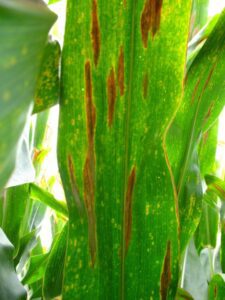
Northern corn leaf blight (NCLB) has made its appearance this year in U.S. cornfields. Since this crop disease is now a regular visitor for all of us to contend with, here are some details and ideas for you to consider.
The Facts
- NCLB is a foliar disease caused by the fungus Exserohilum turcicum. Disease development is favored by moderate temperatures (64-81°F) and extended periods of leaf wetness (6-18 hours). Heavy dew, overcast days, or humid field margins near tree lines can create an environment conducive for disease.
- Exserohilum turcicum overwinters in corn residue, allowing inoculum to build up from year to year. Cropping systems with reduced or no-till and/or continuous corn are at higher risk of northern corn leaf blight outbreaks.
Identifying NCLB
- Infections generally begin on lower leaves and progress up the plant, but infections may begin in the upper plant canopy when spore loads are high. Spores progress up the plant by wind or rain splash and may be carried long distances by the wind. With optimum conditions, lesions can form 7 to 12 days after infection.
- Lesions are unrestricted by leaf veins, beginning as elliptical and becoming long, narrow, and “cigar shaped”. Coloration of lesions starts as tan or gray-green and takes on a darker shade as Exserohilum turcicum sporulates. Spore coloration ranges from olive green to black and can be visible with a hand lens. Lesions are often described as appearing “dirty”.
- Lesions can coalesce to form large areas of necrotic leaf tissue, making leaves appear gray/burned. New lesions can produce spores in as little as one week, allowing northern corn leaf blight to spread much faster than many other corn leaf diseases.
What to Do
We recommend working closely with your local AgVenture Yield Specialist (find yours) to:
- Identify corn hybrids available in our line-up that offer specific resistance to NCLB as a first line of defense.
- Initiate a season-long cropping plan that includes timely fungicide applications to promote yield enhancement, crop stress relief and of course disease control.
- Target problem fields for an opportune harvest schedule as advanced NCLB outbreaks can cause early stalk deterioration.
Adhere to our unique Maximum Profit System™ approach to manage your crops with a resilient attitude, paired with our outstanding seed quality initiatives and localized product expertise, which can make instances of NCLB and other problem pests less of a hindrance on your journey to your best crop ever.